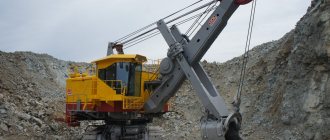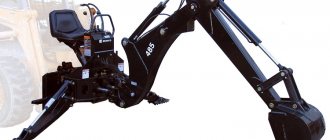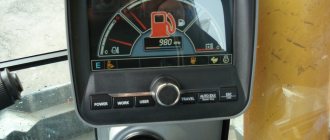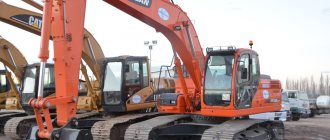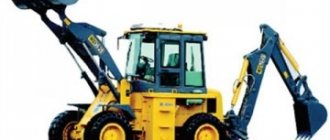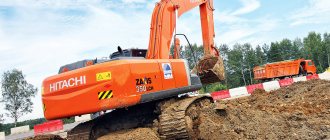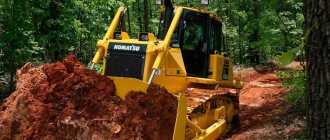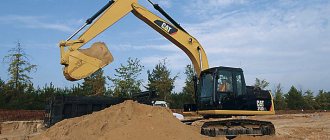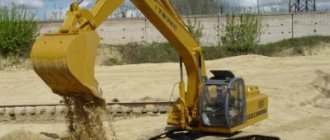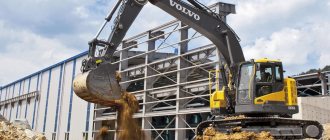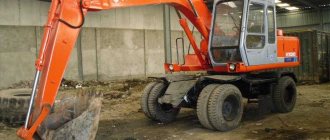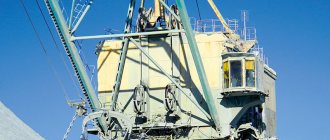The bucket wheel excavator is a giant machine, the largest combine on the planet, built specifically for mining. Its length is 220 m, height is 94 m. The mechanism is capable of extracting coal at a depth of hundreds of meters underground. He succeeds in this thanks to a huge wheel with suspended buckets, which is supported by a boom about 60 m long. As the wheel rotates, the buckets pick up soil and pour it onto large conveyors, through which it falls into the mines. They sort sand from coal. Coal is transported by railway conveyors to power plants, where it is ignited and electricity is generated.
Description of the bucket wheel excavator
The operation of a bucket wheel excavator comes from electricity, which is supplied to the machine through thick cables. The machine works around the clock and digs up to 245 thousand m³ per day. For comparison, this amount of earth can fill a huge stadium. The tallest units are longer than the Statue of Liberty, and their weight is 13.5 thousand tons, 1.5 times heavier than the Eiffel Tower.
Features of Bucket Wheel Excavator:
- Moves on 12 tracks.
- The height of each caterpillar is 3 m.
- Width - 3.5 m.
- Length - 15 m.
- The price of such a mechanism is $100 million.
- The service life of the machine is 70-80 years.
With smaller tracks, the vehicle would have sunk into the ground. Over the last century, about a thousand wheels of different sizes have been created. It takes years to build the unit. The production of individual parts takes 5 years, and another 5 years are spent on assembly and testing.
General characteristics of bucket wheel excavators:
- Wheel diameter - 18 m.
- Bucket capacity - up to 1600 liters.
- Productivity - 10,000 m³/h.
- Digging depth - 5 m.
Characteristics of rotary trench excavators
During the construction of gas pipelines, a huge role is played by laying trenches for them using multi-bucket bucket wheel excavators. These are powerful machines weighing tens of tons, designed to service pipelines with a diameter of up to one and a half meters.
Basic data of mainline rotary trench excavators Gazstroymashina:
| Options | EVRF1 | ETR254A | ETR254A-01 | ETR254AM | ETR254AM-01 |
| Trench depth (m) | 2,7 | 2,5 | 2,5 | 2,5 | 2,5 |
| Trench width without slopes (m) | 2,7 | 2,1 | 1,5 | 2,1 | 1,5 |
| Power plant power (hp) | 330 | 300 | 300 | 333 | 333 |
| Technical productivity (m3/hour) | 1200 | 1200 | 900 | 1400 | 900 |
| Dimensions (m) | |||||
| length | 13,55 | 14,02 | 13,83 | 14,02 | 13,83 |
| width | 6,7 | 3,20 | 3,20 | 3,20 | 3,20 |
| height | 4,76 | 4,35 | 4,10 | 4,35 | 4,10 |
| Weight (tons) | 55,0 | 49,5 | 46,5 | 49,5 | 46,5 |
All of these machines have a tracked drive with little pressure on the ground, and the same operating and transport speeds. The rotors have from 16 to 24 buckets.
Their working equipment is:
- articulated frame or rotor for mounting buckets
- metal structures for frame fastening
- power equipment with drive mechanisms
- platform for installing components and assemblies
- chassis, which can be tracked or pneumatic.
The most powerful and heaviest excavator is EVRF1. This is a rotary milling machine that ensures the opening of underground pipelines of maximum diameter for their major or routine repairs. Monitoring and control systems ensure that pipelines are not damaged during machine operation. Its slight modernization allows you to backfill pipes in a trench, as well as restore damaged areas of the ground .
Somewhat smaller parameters of the ETR254A excavator and its modification ETR254A-01. They are distinguished by high performance and reliability, ease of operation. In addition to creating trenches for main pipelines in soils of varying hardness. They are used in road construction, land reclamation, and land reclamation. Models ETR254AM and ETR254AM-01 are close to the performance of these machines.
Of the six trench excavator machines, there is only one - ETRF121 is designed for trenches for pipelines with a diameter of up to 325 mm. Here the working body is connected to the tractor tractor with a hinge, which makes operation easy. The tractor has additional final drives and continuously variable hydraulic drive control. With replaceable working parts, it can open asphalt and concrete pavements and dig trenches for laying cables and drainage systems. With a length of 7.3 m and a width of 2.25 m, it can be transported by conventional vehicles. Weight does not exceed 10 tons.
Rotary excavator ERSHRD-5000, ER-1250 and Bagger 293
In 1974, the Bogatyr coal mining enterprise in Kazakhstan began producing the most powerful rotary excavator ERSHRD-5000 in those years. The team was headed by electrician A. Shilov. It was planned that the productivity of the equipment would be 5000 m³. In 1976, the excavator was submitted for technical inspection, and in 1978, it was put into operation. A month later, an all-Union record for coal production was set, when instead of the planned 950 thousand tons, 1162 thousand tons of coal were produced.
The Bagger 293 rotary excavator is a German-made equipment that was built in 1995. The car was included in the Guinness Book of Records due to its size and performance. The total weight of all equipment is 14,200 tons. In just one day, it is capable of digging a huge 10-meter pit the size of a football field. There are 20 buckets with a size of 15 m³ installed on the rotary wheel of the machine. The only analogue of Bagger 293 is Takraf, operating in the city of Hambach (Germany) in a coal mine.
The ER-1250 rotary excavator is a Soviet-era technique designed for quarrying in open areas for mining. It differs from the machines described above in its smaller size, although for urban purposes it is considered a giant. The length of the structure is 48 m, and the height is 22 m. The total weight is 700 tons.
According to the classification, bucket wheel excavators are divided into overburden, mining and trench excavators. If the above rotary machines are huge in size, then the excavator, which will be discussed further, is not so large and is intended for trench work.
Rotary trench excavator ETR-254
The ETR-254 rotary trench excavator is designed for longitudinal digging of trenches for oil or gas pipelines with a diameter of: 1220; 1420; 1620 mm. The machine can work in soils from the first to fourth categories, as well as with frozen soil at a temperature of -40ºС.
The base of the design is a crawler tractor. The working part of the mechanism is a frame with a rotor (or two rotors) attached to the tractor. This is a large longitudinally rotating wheel with built-in buckets or cutters, capable of digging a trench 3.5 m deep.
The design of the rotary mechanism came to the mind of Leonardo da Vinci. Back in the 16th century, he proposed the idea of a wheel with scoops digging the ground. In the 19th century, an early version of such a machine was used to dig the Suez Canal. The American engineer Smith in 1884 created a rotary trench mechanism with two rotating wheels.
In 2001, in the German city of Jülich, people witnessed the moving giant Bugger 288. Such equipment is usually moved over long distances in a disassembled state, but the quarry to which the equipment was moved was only 22 km away.
The price of cars and spare parts depends on the model, condition and other nuances. The cost can be found in the “buy equipment” section on various portals about excavators (depending on the region).
An interesting technology is the use of ETR-254-01 in permafrost soils with a strength of up to 400 kgf/cm2 when developing wide-profile trenches for laying loaded pipelines with a diameter of 1420 mm with reinforced concrete loads of the UBO type in areas with a depth of 2.2 to 2.5 m and a width of 3 m. Development trenches in such areas are produced by an in-line complex-combined method: first, along the border of one side of the trench, a pioneer trench is developed along the border of one side of the trench using a rotary trench excavator ETR-254-01 with a working body width of 1.2 m, which is filled with a Komatsu D-355A, D-455A or DZ bulldozer -27C. Then, at a distance of 0.6 m from it, an ETR-254-01 rotary excavator develops a second trench 1.2 m wide, which is also filled with loosened soil using the same bulldozers. The final development of the design trench profile is carried out using a Kato ND-1500 single-bucket excavator, which simultaneously with excavation
The soil of the pioneer trenches, loosened by rotary excavators, is developed and the soil pillar between them is developed.
Similar technologies, only without backfilling, were widely used in mining on frozen soils.
Source: techstory.ru. With gratitude and respect to A. Buzdin.
The design of the excavators was developed by SKB "Gazstroymashina" according to the initial requirements of VNIIST and Glavtruboprovodstroy; were produced by the Moscow Experimental Mechanical Plant (MEMZ) of the Ministry of Oil and Gas Construction at the request of central administrations and associations.
The ETR-254 excavator (basic model) is designed for developing trenches for main pipelines with a diameter of 1220, 1420 and 1620 mm at a digging depth of 2.5 m (720, 920 and 1020 mm at a depth of 2.5 m - for ETR-254-01; 1220 and 1420 at a depth of 3 m - for ETR-254-02). The main design differences between the ETR-254-01 excavator and the ETR-254 are as follows: smaller rotor width with a single-row arrangement of buckets; single rear support wheel; single-speed helical conveyor drive gearbox. The tractor, the linkage system and the connection between the tractor and the working element, as well as a number of components of the working element are completely unified with the same components of the ETR-254 excavator.
The base of the excavators is a special tractor, the design of which uses all the main and transmission components of the K-701 tractor and the chassis components of the T-130 tractor. The travel drive is mechanical, with hydraulic gear shifting; the rotor and conveyor drive is mechanical, the lifting of the working parts is hydraulic; drive engine - YaMZ-240B (YaMZ-240BM) with a power of 300 hp; excavators have 32 working speeds (from 20 to 509 m/h).
Prototypes of the ETR-254-01 excavator were tested on the construction of a gas pipeline in the area between Urengoy and Nadym, where they showed good results and their serial production began in 1982. In the winter season of 1982-1983, an installation batch of ETR-254-01 excavators completed a large amount of work in the Urengoy gas fields, and ten of the same machines from February to April 1983 dug about 240 km of freezing trenches in frozen and permafrost soils to full depth!
The ETR-254-05 excavator has a device for soil reclamation - two additional rotors installed on both sides of the main rotor. With one pass along the axis of the trench, a rotary reclaimer removes the fertile soil layer from a strip 3.5 m wide. For this, ETR 254-05 excavator conveyors, which have a hydraulic suspension, are equipped with a device that increases the soil transportation range to a distance of 11-13 m from the edge of the reclamation strip to the middle of the dump.
To implement slot technologies for developing trenches in permafrost soils (MPF), in the 80s, attempts were made in the pipeline construction industry to create a slot cutter with a digging depth of 2.5 m. The experience of using domestic rotary excavators of medium and high power for developing trenches in MMF has shown high efficiency , due to the “large chip” method of cutting soils, but only with a specific power of 200 hp. and more per square meter of the cross-sectional area of the trench. With a specific power of less than 100 hp/m2, the process of cutting MMG turns into a process of wear of teeth on emery.
Tests of two prototypes showed the inability of bucketless working bodies to lift soil from a depth of more than 1.5 m. After an unsuccessful attempt to create a bucketless slot cutter, VNIIST got the opportunity to implement a slot cutter project with a bucket (rotary) working body that implements the “large chip” principle of cutting soil. A prototype of a slot cutter with a digging depth of 3 m and a working tool width of 0.5 m was created as a replacement working tool for the serial ETR-254-01 rotary excavator.
The working body is equipped with a wheel support in the transport position. In the working position, the working element rests on a rigid support, and the wheel support moves along the berm of the trench. The rotor drive is mechanical, interchangeable with ETR-254-01, the conveyor drive is hydraulic. Acceptance tests were carried out at the Yamburgskoye field. The ability to develop durable MMGs with a speed of 80-100 m/h was confirmed. Based on the results of acceptance tests, the slot cutter was included in the industry catalog of pipeline construction equipment under the index ETR-254-06.
The ETR-254A excavator is a modernization of the ETR-254 excavator. The tractor and the working part of the excavator were modernized. The modernization of the tractor included lengthening the caterpillar track, reducing the overhang of the power unit and cab, and lowering the tension and drive wheels. The rear axle has been strengthened and ergonomic characteristics have been improved. A reduced operating speed has been introduced for more stable operation of the excavator on particularly strong soils.
When modernizing the working body, the strength of the rotor buckets, the durability of the rack and pinion gearing, support and guide rollers, the chain drive, and the reliability of the conveyor drive were increased. The energy consumption of digging has been reduced by improving the arrangement of the teeth of the rotor buckets. The designs of the limiting torque clutch and the rotor reverse gear have been changed, which provide more reliable protection of the transmission from overloads.
